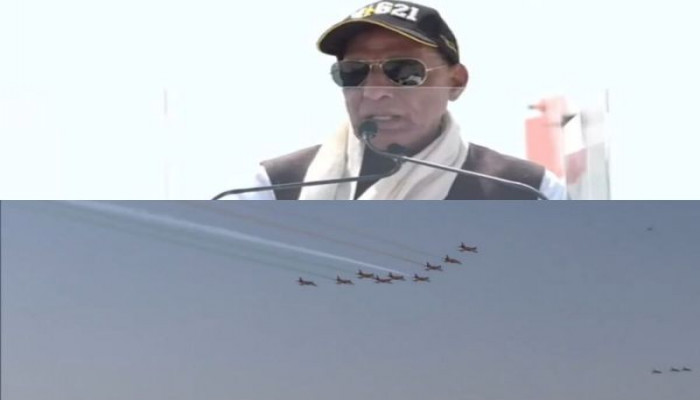Defence Minister Rajnath Singh pays tribute to legendary MiG-21 at farewell ceremony
- In Reports
- 06:57 PM, Sep 26, 2025
- Myind Staff
Defence Minister Rajnath Singh on Friday led the farewell ceremony of the MiG-21 in Chandigarh, describing the aircraft as a trusted companion of India’s armed forces for more than six decades and recalling its presence in every major conflict from 1971 to Kargil, as well as in Balakot and Operation Sindoor.
Air Chief Marshal A P Singh flew the final sortie, marking the official end of the fighter’s service. The aircraft took off in the signature ‘Badal’ formation, three planes flying in an inverted V, while the Surya Kiran aerobatic team performed manoeuvres with their BAe Hawk Mk132 jets.
The MiG-21 first joined the Indian Air Force in 1963. With its retirement, an era of 63 years came to a close. After the last landing, the fighter received a water cannon salute, and Air Chief Marshal Singh presented its Form 700 logbook to the Defence Minister.
Addressing the gathering, Rajnath Singh said the aircraft was far more than just a machine. “MiG-21 has been a witness to many heroic acts for a long period,” he said, noting its role in Dhaka during the 1971 war. “Who can forget the 1971 war. In the war against Pakistan, under unfavourable conditions, the MiG-21 bombed the Governor's House in Dhaka, and on the same day, it defined the outcome of that war.”
He stressed that the MiG-21 was both a symbol of India’s strength and a marker of its partnership with Moscow. “MiG-21 is not a machine, it is a witness to India-Russia relations,” he said.
Singh described the farewell as the departure of a national icon. “Wherever there have been historical missions, each time the MiG-21 has elevated the glory of the tricolour. Hence, this farewell also pertains to our shared memory, to our national prestige, and to that journey on which the history of courage, self-sacrifice, and excellence has been scripted.”
Calling the fighter “a family member,” Singh added that it had given India strategic confidence and helped the country establish its place globally. “The MiG-21 is etched in the hearts and minds of our nation. Since 1963, when the MiG-21 joined us, this 60-year-long journey until now stands unique by itself. For all of us, this is not only a fighter aircraft but a family member with whom we have a strong connection.”
He also sought to clarify frequent claims that the IAF was flying “60-year-old jets.” According to him, most of the MiG-21s in recent use were closer to 40 years old, which is standard globally for such fighters. “The MiG-21 aircraft that arrived in our military forces during the 1960s and 1970s have been out of service for a long time. The MiG-21 aircraft on which we were flying until now were no more than 40 years old. A 40-year lifespan is entirely within the norms of such an aircraft,” he said.
The Defence Minister thanked Hindustan Aeronautics Limited for continuously upgrading the fighter with modern radars and avionics. “The MiG-21 that we are viewing has also been referred to by the names Trishul, Vikram, Badal, and Bison. Its present configuration was upgraded. I also thank Hindustan Aeronautics Limited, which has played its crucial role in upgrading the MiG-21 continuously with its cutting-edge radars and avionics.”
The ceremony ended with a symbolic flypast of MiG-21s alongside indigenous Tejas aircraft, underlining the passing of the baton to India’s new generation of fighters.







Comments